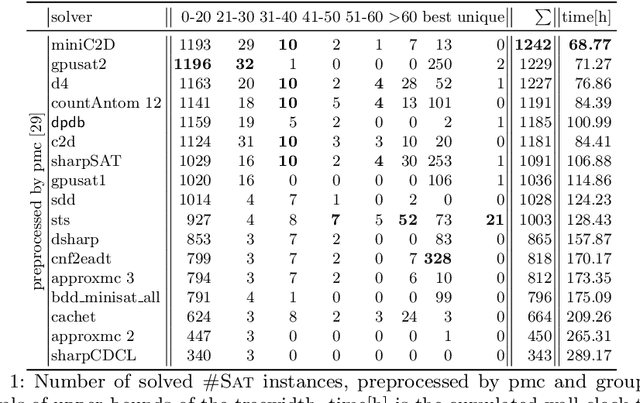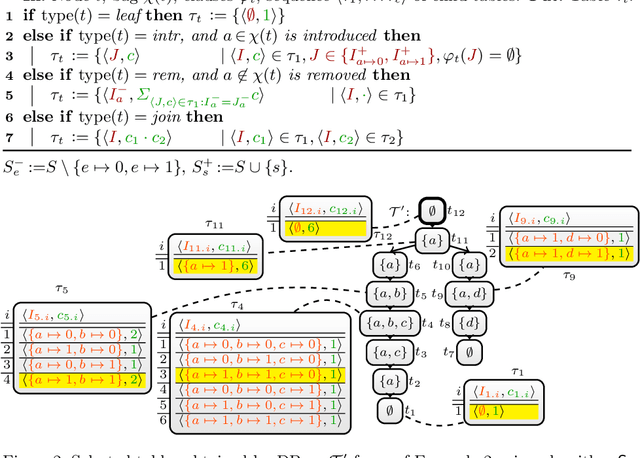Patrick Thier
Solving Projected Model Counting by Utilizing Treewidth and its Limits
May 31, 2023Abstract:In this paper, we introduce a novel algorithm to solve projected model counting (PMC). PMC asks to count solutions of a Boolean formula with respect to a given set of projection variables, where multiple solutions that are identical when restricted to the projection variables count as only one solution. Inspired by the observation that the so-called "treewidth" is one of the most prominent structural parameters, our algorithm utilizes small treewidth of the primal graph of the input instance. More precisely, it runs in time O(2^2k+4n2) where k is the treewidth and n is the input size of the instance. In other words, we obtain that the problem PMC is fixed-parameter tractable when parameterized by treewidth. Further, we take the exponential time hypothesis (ETH) into consideration and establish lower bounds of bounded treewidth algorithms for PMC, yielding asymptotically tight runtime bounds of our algorithm. While the algorithm above serves as a first theoretical upper bound and although it might be quite appealing for small values of k, unsurprisingly a naive implementation adhering to this runtime bound suffers already from instances of relatively small width. Therefore, we turn our attention to several measures in order to resolve this issue towards exploiting treewidth in practice: We present a technique called nested dynamic programming, where different levels of abstractions of the primal graph are used to (recursively) compute and refine tree decompositions of a given instance. Finally, we provide a nested dynamic programming algorithm and an implementation that relies on database technology for PMC and a prominent special case of PMC, namely model counting (#Sat). Experiments indicate that the advancements are promising, allowing us to solve instances of treewidth upper bounds beyond 200.
Exploiting Database Management Systems and Treewidth for Counting
Jan 13, 2020



Abstract:Bounded treewidth is one of the most cited combinatorial invariants, which was applied in the literature for solving several counting problems efficiently. A canonical counting problem is #SAT, which asks to count the satisfying assignments of a Boolean formula. Recent work shows that benchmarking instances for #SAT often have reasonably small treewidth. This paper deals with counting problems for instances of small treewidth. We introduce a general framework to solve counting questions based on state-of-the-art database management systems (DBMS). Our framework takes explicitly advantage of small treewidth by solving instances using dynamic programming (DP) on tree decompositions (TD). Therefore, we implement the concept of DP into a DBMS (PostgreSQL), since DP algorithms are already often given in terms of table manipulations in theory. This allows for elegant specifications of DP algorithms and the use of SQL to manipulate records and tables, which gives us a natural approach to bring DP algorithms into practice. To the best of our knowledge, we present the first approach to employ a DBMS for algorithms on TDs. A key advantage of our approach is that DBMS naturally allow to deal with huge tables with a limited amount of main memory (RAM), parallelization, as well as suspending computation.
 Add to Chrome
Add to Chrome Add to Firefox
Add to Firefox Add to Edge
Add to Edge